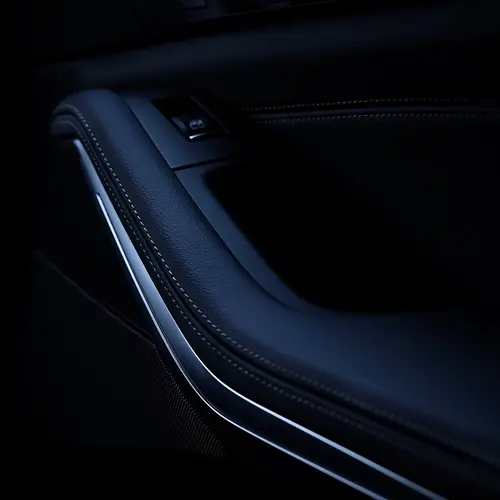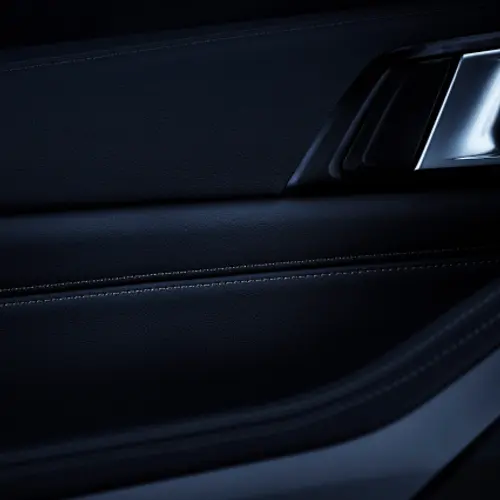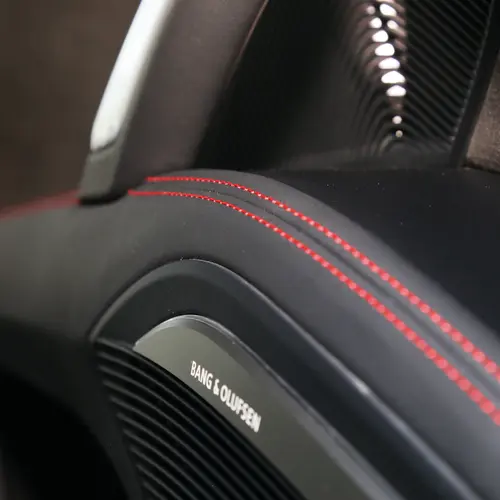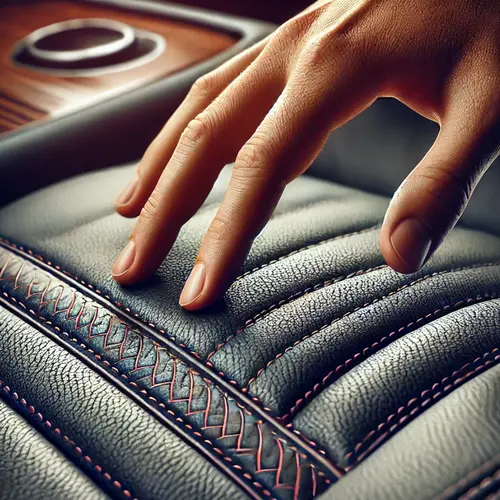
Press lamination
Efficiency and Precision
vacuum lamination
Perfection for Complex Geometries
hand lamination
Tailored Solutions for Individual Requirements
Well advised
With our experts, quickly achieve the perfect design
Material Variety
Textiles, Synthetic leather, Vegan leather, foams, and much more
High Design Flexibility
Complex Shapes and Structures
35 years of experience
For the quality of your projects
Press lamination
Efficiency and Precision
vacuum lamination
Perfection for Complex Geometries
hand lamination
Tailored Solutions for Individual Requirements
Well advised
With our experts, quickly achieve the perfect design
Material Variety
Textiles, Synthetic leather, Vegan leather, foams, and much more
High Design Flexibility
Complex Shapes and Structures
35 years of experience
For the quality of your projects
An overview
Lamination in the Automotive Industry: Combining Functionality and Aesthetics
At MODELLTECHNIK, we offer three core lamination techniques that enable us to flexibly adapt to various requirements and material properties. Each method has specific advantages that make it particularly suitable for different applications.
Design as unique as your project
Types of laminating
Press lamination
In press lamination, material layers are bonded together under controlled heat and high pressure. This process is particularly suitable for flat or slightly curved components where uniform and robust connections are required.
Vacuum lamination
Vacuum lamination is the optimal solution for components with intricate shapes and surface structures. In this process, a vacuum is created, drawing the laminating material tightly against the component to achieve a seamless bond – even on highly curved or textured surfaces.
Manual Lamination
Manual lamination is the most flexible lamination process, ideal for components requiring customized and detailed handling. In this process, the lamination is performed entirely by hand, allowing for precise adjustments and the highest quality results.
LAMINATION
Innovative lamination processes for the highest design requirements.
In press lamination, the materials to be processed, such as plastics, textiles, or foams, are carefully prepared and coated with an adhesive layer. The coated layers are then placed into a specialized press that simultaneously applies pressure and heat to the materials. The heat activates the adhesive, creating a strong and permanent bond between the layers. Typical applications of press lamination include a wide range of products requiring smooth or slightly curved surfaces. These include door panels, which benefit from enhanced functionality and aesthetic appeal through this process. Additionally, press lamination is ideal for flat decorative elements such as trim strips and console covers, which stand out due to precise workmanship and high-quality materials.
Advantages
Consistent results with high production volumes
High stability and bonding strength of the connection.
Fast and efficient process, ideal for series production of prototypes.

Leather-laminated door panel with contrasting decorative stitching and chrome-plated handle.
Vacuum Laminating
Perfection for Complex Geometries
Vacuum laminating is the optimal solution for components with demanding shapes and surface structures. This process creates a vacuum that pulls the laminating material tightly onto the component, enabling a seamless bond – even on highly curved or textured surfaces. The base material, such as a dashboard, is first prepared with adhesive. The laminating material, like synthetic leather or films, is then heated to make it more flexible. Using a vacuum, the material is tightly drawn onto the base material, conforming precisely to all contours. Once cooled, a permanently stable bond is created.
Advantages
Perfect adaptation to complex shapes and structures.
Seamless, bubble-free results.
High design flexibility, such as integrating surface textures.

Laminate with contrasting decorative stitching
Hand Laminating
Tailored Solutions for Individual Requirements
Hand laminating is the most flexible laminating process and is particularly suitable for components that require individual and detailed craftsmanship. In this process, the laminating is carried out entirely by hand, allowing for precise customization and the highest quality. The material is first manually cut and precisely adjusted to fit the shape of the component. Then, the adhesive is carefully applied to ensure an accurate and secure bond. Finally, with skilled craftsmanship, the laminating material is meticulously applied to avoid wrinkles or air bubbles.
Advantages
Maximum flexibility in working with various materials.
Ideal for prototypes, custom-made products, or small production runs.
Perfect results for complex or highly delicate components.

Hand Laminating: Feel the precision, experience the quality.
Where is laminating used?
Laminating is used in numerous industries, such as the automotive industry, furniture manufacturing, aerospace, and the production of prototypes and custom-made products. The flexibility of the process allows for the precise processing of a wide variety of materials and shapes.
Door panels
with smooth, textured, or slightly curved surfaces. Here, laminations also provide functional aspects such as abrasion resistance, durability, sound absorption, UV resistance, water repellency, and thermal insulation.
Flat decorative elements
such as trim strips and console covers
Dashboards
with curved lines and details
Complex components
where precision and attention to detail are crucial
Unique pieces or special models
with specific design requirements
Prototypes
that require adjustments during the development phase
Small components
with complex geometries
Advantages of Lamination
Lamination offers a wide range of benefits, covering both functional and aesthetic aspects. These advantages make it an indispensable technique in the manufacturing of modern products, especially in the automotive industry.
- Protection and Durability of Surfaces
A key advantage of lamination is the protection of sensitive materials:
• Mechanical Protection: Laminated surfaces are more resistant to scratches, impacts, and abrasion, significantly extending the lifespan of components.
• Moisture and UV Protection: Laminated materials are often water-repellent and UV-resistant, ensuring durability even under extreme conditions.
• Thermal Stability: Specialized lamination materials provide thermal insulation, which can be crucial in areas such as engine covers or vehicle interiors. - Enhanced Aesthetics and Tactile Quality
Lamination allows for the combination of function and design, which is particularly important in the automotive industry:
• Premium Appearance: Laminated surfaces can feature various textures and designs, ranging from elegant leather looks to modern carbon fiber patterns.
• Pleasant Feel: Laminated textiles or plastics create surfaces that are not only visually appealing but also feel high-quality and comfortable.
• Custom Adaptation: Lamination enables tailored designs that perfectly align with an automotive manufacturer’s corporate identity. - Efficiency and Sustainability
• Lightweight Materials: By using laminated composite materials, lightweight yet robust components can be produced, contributing to vehicle energy efficiency.
• Sustainable Materials: Modern lamination techniques allow the integration of recycled or biodegradable materials without compromising quality or functionality. - Lamination at MODELLTECHNIK: Your partner for customized solutions
When it comes to laminating prototypes and small series, ModellTechnik Rapid Prototyping GmbH is the right partner. With our years of experience, we implement your requirements precisely and efficiently.
Our range of services includes the three most important types of lamination: press lamination, vacuum lamination, and manual lamination. This enables us to offer the right solution for every project, whether for complex prototypes or custom-made special designs. We place particular emphasis on:
• Quality: All laminated components meet the highest standards of functionality and design.
• Flexibility: Thanks to our extensive network, we can respond to specific requirements and deliver customized solutions.
• Customer Focus: We support you from the initial idea to final implementation and provide expert guidance throughout the entire process.Interested in our services? Use our contact form to reach us directly. Our team looks forward to realizing your lamination project and delivering high-quality results.
Our case studies
MODELLTECHNIK IN ACTION
Automotive
A body with class: We produced the master model for the body of the cult Evetta light electric vehicle on a 1:1 scale – with perfect milling and the finest surface finishing. Find out how.
Industry
The socket for the forest: We developed the prototypes for a type of powerbank for Stihl, which was put through its paces by forestry workers. A truly powerful project.
Aerospace
"Jena, we have no problem": Jena-Optronik commissioned MODELLTECHNIK to produce a 1:1 model of the Gateway Docking Port, which is needed for sensor tests in space applications.
Design
Timeless and dignified: Working with Samosa and our expertise in 3D printing, MODELLTECHNIK creates beautiful templates and design samples for individually designed funeral urns.
Contact us
Whether you’ve got technical, commercial or specialist questions – we’re here to help.
START A QUERY NOW„Spot-on delivery under extreme time pressure [...] It couldn't be more perfect“
„Spot-on delivery under extreme time pressure [...] It couldn't be more perfect“